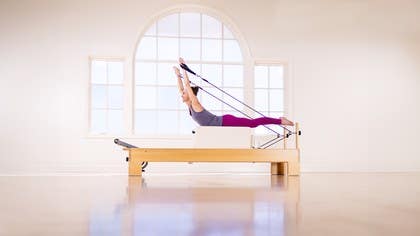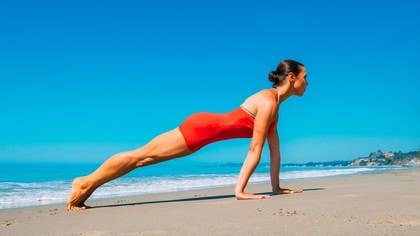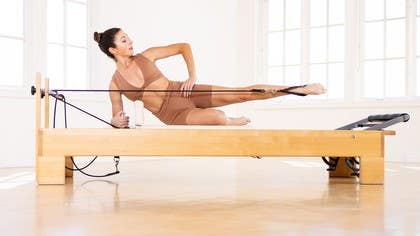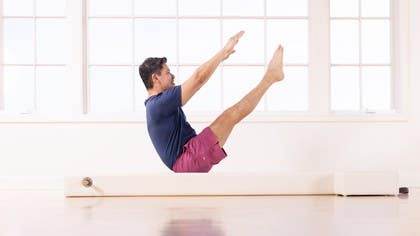
How to Establish a Pilates Routine and Stay Motivated as a Beginner
If you have just started or are thinking about starting your journey into the world of Pilates – a method of exercise created by Joseph Pilates – you may have many questions about how to begin and when to expect results. Contrology (what Joseph Pilates named it) is a full-body system that will challenge your body and your mind. The main reason that Pilates has withstood the test of time is it works.
Challenges in Starting a Pilates Practice
Sometimes, newcomers to Pilates have trouble establishing a consistent practice for the following reasons:
- It feels “slow.”
- The words and terms are confusing, and coordinating instruction with movement is challenging – there’s so much going on at once.
- It’s expensive.
- It’s intimidating to enter a new studio.
- It can be hard to fit into your schedule – “I’m too busy!”
- It can be difficult to stay motivated to keep up a Pilates practice.
Fortunately, in the root of every problem lies the seed of a solution. And Pilates teachers and advocates are at their “core” problem solvers!
Solutions to Common Beginner Pilates Challenges:
PROBLEM: It feels slow. If you love to sweat buckets doing cardio in a spin studio or on a treadmill, or with a high-intensity workout like CrossFit, Pilates will undoubtedly be a change of pace. At least in the beginning. However, that deliberately slow pace allows you to activate stabilizing muscles you don’t even know you have. Precision occurs when you slow down. Those newly discovered muscles will improve your appearance and the way you perform in your other physical activities. So “Slow down Speed Racer!”
SOLUTION: Recognize that the intense concentration of connecting the mind to the body is the key to continued physical success – it’s the fountain of youth of physical wellness, as it prevents injury and promotes strength and length. As your practice continues, you will find you can workout at a quicker pace and indeed, see you can easily build up a sweat.
It’s not just the body. A comprehensive medical study compiling data from not one but two universities has proven that 10 weeks of a Pilates practice improved cognitive functions, including increased neural network activity, better judgment, and improved memory.
When will I start to see results from Pilates? Remember that nothing worth having comes easily, so try not to get frustrated with slow results. Most people will notice that they start to feel better within about 10-12 consistent classes. Many will hear comments like, “You look taller,” after just the first class.
PROBLEM: It’s downright confusing. “Pull your navel to your spine” or “Find a neutral pelvis” sound like a foreign language to most beginners, and it’s difficult to follow any instruction when it’s not in the language you speak!
SOLUTION: Start with a private session so you can ask your teacher questions if you don’t understand what they are saying. If this is not an option for you, you can also try online classes. This video will detail the 10 most common cues you’ll hear in a Pilates class - whether in-studio or online – so you won’t feel completely lost. Think of it as a Pilates vocabulary lesson.
PROBLEM: It’s expensive. Sure, private sessions can add up, but there are other options that will help!
SOLUTION: If private sessions aren’t in your budget, you can always opt for group classes. Many studios offer packages that will give you a discounted rate per class. You can also use your PilatesAnytime membership to help you keep up your practice in between studio sessions.
PROBLEM: It’s intimidating. How many times have you heard “the only person you should compare yourself to is the person you were yesterday” – I mean, we get it, but comparison is human nature; when you’re struggling, it can be pretty frustrating (and distracting) to see Piper the Petite Pilates Princess in your peripheral vision performing a Teaser with perfect form without breaking a sweat.
SOLUTION: An online Pilates membership affords you the ability to practice in the comfort of your own home, distraction-free.
PROBLEM: Pilates doesn’t fit in my schedule. Most studio classes last 60 minutes and are at specific times during the day, which often are impossible for people with busy schedules.
SOLUTION: Online Pilates memberships offer classes anywhere from 10 to 90 minutes long – simply pick how much time you can budget on any given day. Since videos are available online, on-demand, you can squeeze a practice in before the kids wake up for breakfast, when you get home from work, and everywhere in between.
PROBLEM: I have difficulty staying motivated to keep up a Pilates routine. Establishing a Pilates practice is no different from creating any other physical activity routine, whether it’s jogging, taking up yoga, or getting back into a favorite sport.
SOLUTION: When practicing Pilates at home, you want to make Pilates a habit – something that comes naturally. A few ways to do this:
- Schedule specific times in your weekly calendar to practice. We recommend 2-3 times per week to start. Pen (don’t pencil!) your Pilates workout in just like you would any important meeting – it’s a meeting with yourself; what’s more important than that?!
- Join a challenge or follow a playlist: this 10-class starter series Pilates playlist will have you ready to begin a Pilates challenge such as this one, which is beginner-friendly. Having a set playlist, or a challenge daily, ensures that you won’t be worrying about looking up what class to do next – it keeps things interesting and on track.
- Recruit a friend: the friend doesn’t need to be making Pilates a goal – the purpose is to keep each other accountable. Establish a time daily to check-in with each other to ensure that you both meet your daily requirements.
Sometimes life gets busy, but nobody ever regrets a Pilates class! Pilates centers your mind and body, and a Pilates class is the perfect remedy for a stressful day.
Comments
No comments yet. Be the first!












You need to be a subscriber to post a comment.
Please Log In or Create an Account to start your free trial.